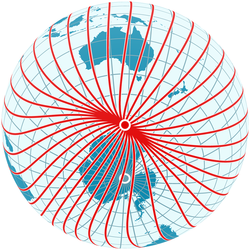Meridians
| Style over substance Pseudoscience |
| Popular pseudosciences |
| Random examples |
In general, a meridian refers either to a pathway, or to an imaginary line, arc or circle that connects two fixed points on a body (human or celestial).
Acupuncture
In acupuncture, the meridians are paths through which chi (life force) flows around the body. Traditionally there are twelve meridians, each associated with an organ of the body: the meridians of the bladder, gallbladder, heart, large intestine, small intestine, kidneys, liver, lungs, spleen, stomach, pericardium, and "triple heater" (三焦 or san jiao) also known as "triple burner" in English. "Triple heater" is by necessity a translation from the Chinese; as there is no such organ, there is no correct medical term for it.[note 1] Some texts list more than twelve meridians, but the twelve listed above are the traditional meridians in Chinese medicine.
Geography
In geography, a meridian is a line or arc of longitude, which runs due north to due south. There are two types of meridians.
Terrestrial meridians
A terrestrial meridian is an arc that runs from the North Pole to the South Pole. The meridians as shown on today's maps and globes were first established in 1851 by Sir George Airy, who used a point at the Royal Observatory in Greenwich, England as the reference point of 0o longitude, now known as the Prime Meridian or the Greenwich Meridian. There are 24 standard meridians that occur every 15 degrees. Each of these meridians roughly correspond to the border of one of the standard time zones.
All meridians intersect lines of latitude[note 2] — called parallels — at right angles. When used together, meridians and parallels are the basis of the coordinate system used by geographers.
Guide meridians
Guide meridians, in combination with parallels called baselines, are used by American geographers to establish private and public property boundary lines within 30 of the 50 states. This system was established in 1785 by the pre-constitutional U.S. government to make plats of lands located west of the Appalachian Mountains.
The government adopted the standardized platting system to replace the British system of metes and bounds. This older system, used in the original 13 colonies, is still used in those 13 states and in the states that were be carved out of them (i.e., Vermont, Tennessee, Kentucky, Maine and West Virginia). Metes and bounds relies on local landmarks to establish townships and individual lots. (Texas and Hawaii, which were originally sovereign countries, continue to use the systems that were in place when the U.S. annexed them.)
A guide meridian and its corresponding baseline intersect at an established landmark within a state. From there, the land is divided into quadrangles (usually 24 miles by 24 miles), then into townships (usually six miles by six miles), then into square miles (640 acres), then into 40 acre plots. Within cities, towns and villages, land is further divided into individual acres, and finally into individual lots.
Guide meridians are either named (like the Tallahassee Meridian in Florida) or numbered (like the Fourth Principal Meridian in Wisconsin, northeastern Minnesota and northwestern Illinois).
Astronomy
In astronomy, a meridian is an arc on the celestial sphere. The celestial sphere is an imaginary sphere which surrounds the Earth, and whose center point coincides with the center point of the Earth. All imaginary points, arcs and circles associated with Earth's geography — i.e., the poles, lines of latitude and longitude such as the equator, the Prime Meridian, and the Tropics of Cancer and Capricorn — are expanded outward to corresponding points on the celestial sphere. Astronomers use the celestial sphere to create star maps.
See also
Notes
- ↑ Acupuncturists are aware of this, and say that this particular meridian does not associate with one organ, but instead three functions in the torso.
- ↑ Because our planet is an oblate spheroid, not a perfect sphere, ambiguity arises in the measurement of latitude. The normally-cited latitude is geodetic, meaning referenced to the local vertical. Geocentric latitude is referenced to the exact center of the planet. The two latitudes nowhere differ by as much as a degree.

